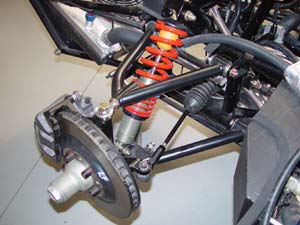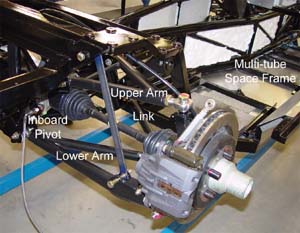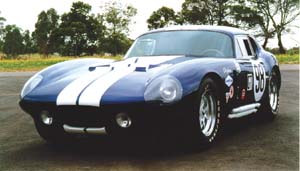The new Coupe’s round tube space frame chassis is as modern as they come. Bob Negstad and Dan Bamford of Roush Engineering completed the chassis design using the latest design techniques and principles. Wes Schultz of ACT did the finite element analysis. Unlike the original 289 chassis, the Superformance Coupe chassis is quite rigid with a torsional stiffness of 6,000 lb-ft per degree.
The design team decided to extend the wheelbase three inches and to increase length, width, and height proportionally. The longer and wider chassis allowed room to optimize the suspension design. The wheelbase and width are close to Bob’s original design for the 427 before AC shortened it.
Bob, Don, and Wes also designed the fully independent suspension. Wes did all the computer design work using the industry standard ANSYS system.
The front is unequal length A-arms with coil over shocks. The rear suspension features unusually long lower arms that pivot almost at the chassis centerline. This unique geometry allows the rear tires to remain in correct alignment with the ground over a wider range of suspension travel and cornering angles than a conventional suspension. The tires therefore stick better than with conventional suspension geometry. The result is a comfortable compliant ride and outstanding handling, a combination rarely found in any car. This unique design was Bob’s last project. He died shortly after it was completed.
The Body Design
The new Superformance Coupe body shape has been designed to conform to Pete’s original design philosophy for the Daytona Coupe and is also based on the aero-technology that he had discovered while at GM. It is not a recreation of the original design, though. It is a step forward in time.
Brock felt that it was important in resizing the form to retain the key proportions, including the roofline, which was never done to his satisfaction with the original cars.

Front suspension with double A-arms, coil over shocks and vented rotors

Coupe rear suspension in final assembly area showing lower arm with inboard pivot, upper arm, trailing link. Coil over shocks will be fitted where temporary bracket connects frame to lower arm.

Design model - 1997